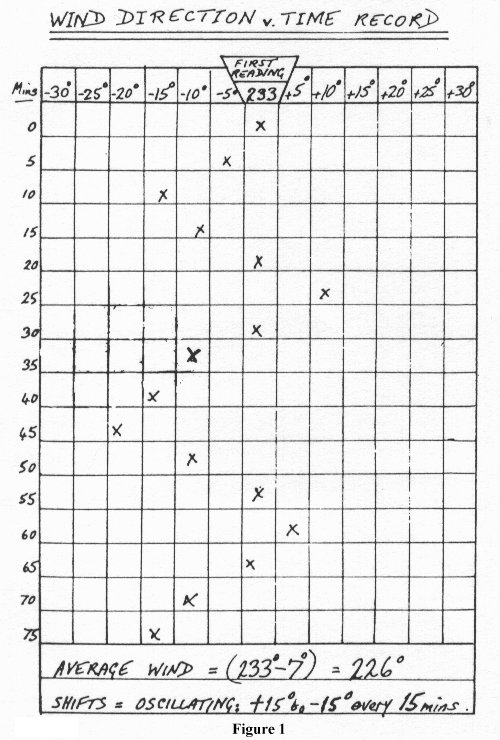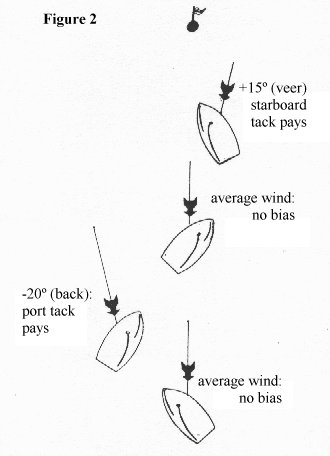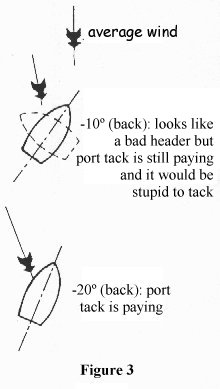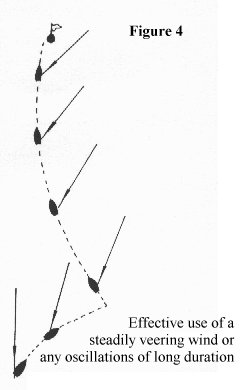|
Windshift
Tracking
Although getting the most speed out
of your boat is important when beating, massive gains can be made by reading
the wind properly. Equally, distance can just as easily be lost by getting
it wrong.
As we all know, the wind is constantly
changing in both speed and direction. These changes may be oscillating
shifts which continually return to an average or mean direction, possibly
at very regular intervals or they can be biased shifts where the mean direction
is also changing, perhaps as it follows the sun in the course of a day.
.....
 |
This is
very common on sea breeze days, for example on the South Coast of England.
There may also be massive sudden shifts which change the whole character
of the race. Further complications occur as the wind bends around topographical
features such as cliffs, hills, large buildings or trees. It can even change
in direction as it leaves the land and blows across water.
The key to understanding and using
shifts to best advantage is observation and recording. If you want to pick
up regular oscillating shifts or a gradual direction change, you need time
and a constant reference point.
Easily the best reference is a compass
but transits can be used on enclosed waters. A recording diagram shown
in Fig. 1 is valuable but quite a time is needed to make a worthwhile
survey.The object of the exercise is to take wind direction readings
every five minutes. The simplest method is to go head to wind and
when the boom is amidships read your compass course.
Completing the form like Fig.
1 will show which of the various types of shift you are having to deal
with. |
.....
| If you discover that you have shifts
on top of an average direction, you can establish your best heading on
port and starboard tacks when the wind is in the average direction, then
ensure that during the race, you spend time on each tack according to the
favoured side of the shift (Fig.2). |
 |
.....
 |
Knowing the mean direction also
prevents you making that easy mistake of tacking when you are headed (i.e.
forced to bear away) by a shift which is still on the good side of average
(Fig.3).
So, if your research
uncovers a changing basic wind you will need to set off on the tack which
is suffering headers and ride out a few before tacking, then gain lift
after lift to bring you quickly up the windward mark (Fig.4).
Wind bends (i.e. a constant
and persistent shift in direction as you sail into it) are actually quite
easy to spot. They can be discovered by beating up the course, noting your
headings. |
 |
....
If these show a gentle but constant
change, perhaps as you approach the shore or headland then you know that
you are in a bend. This is obviously easier to do at Championships but
tough to organise before weekend races, when time is short. Then chatting
up the locals or even just a common sense interpretation of the environment
will have to act as substitute.
The rule then, just as with a changing
basic wind is to sail towards the bend taking the knock. Do not tack early
because you will be on the outside of the bend taking the great circle
route to oblivion. On the other hand leaving it too late and overstanding
will bring other boats up underneath you.
The trick then is to tack a bit earlier
than you would normally do to lay the mark (Fig. 4). You can always
tack back again later if it looks as if you are falling below the mark
and still find room in the boats stacking up on the starboard layline.
Don't forget also, that you must
consider whether tidal streams or waves will override these windshifts,
especially in light or heavy conditions. So make a note of the current
direction and always try to keep it on your lee bow. We'll talk about this
in our next article. (Uncle Al's note: Mike and I are still arguing
over this one. I'm of the opinion you can only lee bow the tide if you're
in water that's shallow enough that your centreboard is in less adverse
current than your hull!)
Finally, the best way of thinking
of headers and lifters is: a header is a change in wind which forces you
to bear away from your previous course and therefore to sail further away
from the windward mark, whilst a lifter is, funnily enough, exactly the
reverse! Auntie Alb |



